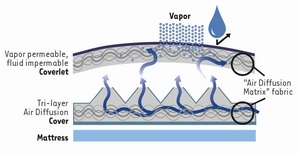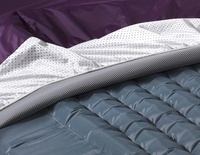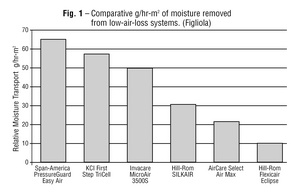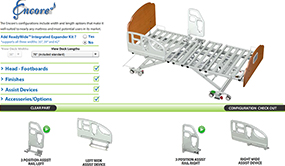|
There is no universally accepted definition of "low air loss" (LAL) in medical
literature. As a result, claims are made that "true" or "genuine" low air loss
referes to construction features such as air flow volume, cover fabric, or air
loss method.
But clinicians primarily prescribe LAL for its unique abilitiy to control maceration
by removing excess moisture. Therefore, scientific measurement of the amount
of moisture it removes is the most meaningful validation of a LAL system's effectiveness.
 Easy Air's exclusive "Air Diffusion Matrix" Coverlet design maximizes removal
of excess moisture (i.e., perspiration) from the user's skin. Moisture passes
in vapor form down through the Coverlet, where a continuous air current takes
it away before it can re-form as liquid. Easy Air's exclusive "Air Diffusion Matrix" Coverlet design maximizes removal
of excess moisture (i.e., perspiration) from the user's skin. Moisture passes
in vapor form down through the Coverlet, where a continuous air current takes
it away before it can re-form as liquid. The Air Diffusion Matrix fabric is not collapsible, ensuring a pathway for a
constant flow of air beneath the patient. Compare to typical low air loss designs
that cause the patient's body to press the cover directly onto the air holes,
closing off the flow of air beneath the patient, between the Coverlet and the
Cover. The Air Diffusion Matrix fabric is not collapsible, ensuring a pathway for a
constant flow of air beneath the patient. Compare to typical low air loss designs
that cause the patient's body to press the cover directly onto the air holes,
closing off the flow of air beneath the patient, between the Coverlet and the
Cover. A study by the Engineering Department at Clemson University shows that the Easy
Air removes more moisture from the patient than other common low air loss designs.*
*Figliola R. A proposed method for quantifying low-air-loss mattress performance
by moisture transport. Ostomy/Wound Management. 2003;49(1):32-41. |
Accessible Navigation
Section Navigation
Search Our Website
Main Navigation
- Products
- Surfaces
- Beds
- Lifts & Slings
- Seating
- Positioners
- Skin Care
- Fall Protection
- Furniture
- About Us
- Clinical/Education
- Videos
- Contact
Footer Navigation
70 Commerce Center
Greenville, SC 29615
800-888-6752
864-288-8692 fax
www.spanbackup.com
©2024 Span America. All rights reserved.
View Accesskeys
Accesskeys
This site contains a number of keyboard shortcuts, called "accesskeys," to assist in navigating. Each Internet browser has a different method of accessing these keys:
- Internet Explorer on a PC use ALT+Accesskey
- Firefox on PC use ALT+SHIFT+Accesskey
- Firefox and Safari on Apple or Linux use CTRL+Accesskey
Please note: Internet Explorer users may also need to hit the “enter” key to activate a link. Apple users with Spaces enabled may need to use the accesskey for Skip to the main navigation (A); then, TAB through the navigation and press "enter" to activate a link.
Page navigation
- 0 : Back to Home
- 1 : Products
- 2 : About Us
- 3 : Clinical/Education
- 4 : Videos
- 5 : Contact
Page jumping
- ? : View Accesskeys
- A : Skip to the main navigation
- C : Skip to the content
- S : Skip to the side bar


